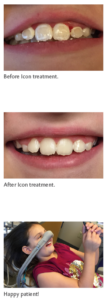By Jeanette MacLean, DDS, DABPD, FAAPD | July 2019

White spot lesions are a common problem following orthodontic treatment, with some studies reporting as high as a 97% prevalence. These unsightly marks can be a source of embarrassment for many patients. Some become disappointed when their attempts to camouflage the lesions by tooth whitening end up making the spots even more noticeable. Historically, these blemishes have been treated with invasive and costly resin fillings, bondings and veneers. Some active carious lesions may naturally reverse in the first few months following de-banding, a result of improved hygiene coupled with remineralization by calcium and phosphate present in the saliva. Unfortunately, many lesions do not reverse. Those that arrest remain white or even turn yellow or brown as they hypermineralize, or worse, some may progress to cavitated lesions. Icon Resin Infiltration represents a revolutionary treatment approach to managing these lesions in one quick, simple, and painless appointment.
Icon-Infiltrant, a highly fluid resin, penetrates deeply into enamel via capillary action which blocks the diffusion pathways for cariogenic acids and arrests the caries process. Further, the refractive index of Icon-Infiltrant mimics the surrounding enamel, creating the optical illusion of healthy enamel with uniform color and long-lasting results. This approach is particularly appealing for young children and adolescents, who are sometimes self-conscious about the appearance of their teeth or the target of teasing, since it can be done at a young age and will not reduce future bond strength. It is also an excellent option for adults who still bear the lingering enamel scars of orthodontic treatment in their youth, a time when perhaps their diet and hygiene was less than ideal. Other advantages include no shots or drilling, conserves natural tooth structure, and results are stable after whitening.
The Procedure
Using the Icon Smooth Surface Treatment kit from DMG, Icon-Etch (15% hydrochloric acid) is applied to the tooth surface for 2 minutes, twice, followed by Icon-Dry (ethanol). Etching may be repeated, as needed, to achieve desired results. Results for stubborn spots may be enhanced by additional rounds of Icon-Etch and/or gently polishing the surface of the tooth. The tooth is then flooded with a highly fluid resin, Icon-Infiltrant, which penetrates deeply into the enamel microporosities via capillary action. After absorbing for 3 minutes, excess Infiltrant is removed and then the tooth is light-cured. The Icon-Infiltrant is applied again for 1 minute, excess removed, light-cured, and then finished with polishing disks.
Case Study
A 9-year-old female patient, accompanied by her concerned mother, presented for a second opinion regarding severe enamel decalcification of her permanent maxillary incisors following 7 months of phase 1 orthodontic treatment. The mother was distraught by the damage to her daughter’s teeth and the prospect of costly and invasive fillings or even crowns, as suggested by a previous provider. The patient, now dental-phobic, was embarrassed to smile due to the extensive discoloration of her teeth. Icon resin infiltration was presented as a minimally invasive option to arrest the carious lesions and reverse the white spots, in addition to a thorough caries risk assessment, nutritional counseling, and oral hygiene instruction. The non-invasive nature of the procedure appealed to them, and she was treated at a subsequent visit with Icon. Her case involved rubber dam isolation, no local anesthesia, and 4 rounds of Icon-Etch, including polishing with a fine-grit polishing disc after the 2nd and 3rd rounds of etch, to achieve the desired results. The mom was thrilled with the outcome and posted the following Facebook review, “this was the best decision I have ever made for my daughter’s teeth. They are so healthy and beautiful. She did a miracle on my daughter’s teeth. And I can say my daughter is so happy with the outcome and is happy to smile again.”
About the Author
Dr. Jeanette MacLean is a Diplomate of the American Board of Pediatric Dentistry, Fellow of the American Academy of Pediatric Dentistry, and a pediatric private practice owner in Glendale, Arizona. She is an advocate of minimally invasive dentistry and you can find more information on this topic at her website, including comprehensive, evidence-based continuing education courses www.kidsteethandbraces.com.
On-Demand DENTALTOWN CE Course
Title: Less is More: Minimally-Invasive Cosmetic Treatment Options for Enamel Defects
Speaker: Dr. Jeanette MacLean | Credits: 3
Course Description: Unsightly congenital enamel defects and acquired white spot lesions can be troublesome for many patients. Historically, these blemishes have been treated with invasive and costly resin bondings and veneers. Dealing with enamel defects can prove particularly troublesome for young patients, which when left untreated, often become a source of embarrassment for the patient. Or worse, some lesions may progress to cavitations, particularly post-orthodontic white spot lesions. In this course, Dr. Jeanette MacLean, an advocate for minimally invasive dentistry, will teach you three simple and painless options to manage enamel defects. MI Paste, ICON Resin Infiltration, and etch/bleach seal can improve or even completely reverse the appearance of congenital enamel defects and white spot lesions while preserving tooth structure and repairing the patient’s natural enamel.
